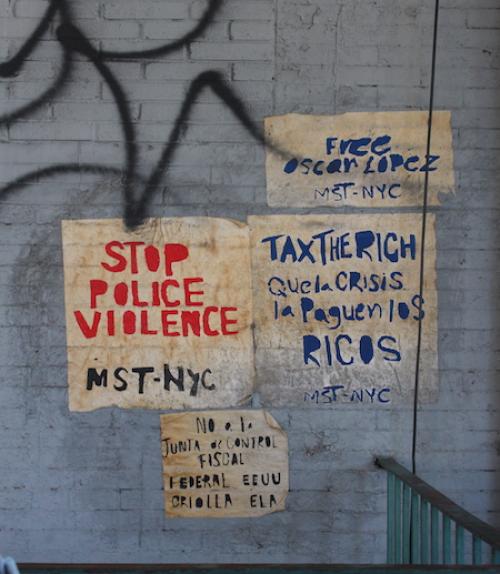From September 8-10, students taking a new Spanish literature course traveled to New York City to examine its identity as a Latinx Caribbean diasporic city.
“Nueva York: Caribbean Urbanisms” is a new four-credit seminar offered by the Department of Romance Studies, and cross-listed with Latina/o Studies, Latin American Studies, American Studies and Africana Studies. The course, taught by Assistant Professor Shawn McDaniel, explores urban cultural influence in New York through the lenses of writers and artists from Cuba, Puerto Rico and the Dominican Republic, from 1880 to the present.
Students come from a diverse range of academic backgrounds and take the course for all different kinds of reasons.
“I come from the city of Chicago, and I wanted to know the impact of the Latino community in New York,” said Jesus Ruiz ’20. Ruiz is a double major in government and Spanish, with a focus and minor in Latin American Politics. “I have seen how we Latinos have molded (Chicago) and changed the dynamics of the city. We have made a home for ourselves, and I wanted to know the history of how the Latino community has done something similar in a different city.”
Rebecca Goldgof ’19, an economics major, shared a different story: “My mom is from Cuba, and I thought it would be interesting to contextualize my family’s experience as immigrants.”
Throughout the semester, students read about places such as Coney Island, Wall Street, Chinatown, East Harlem, the Village, the South Bronx and Washington Heights, in addition to theories of race, space and movement. Topics range from transnational “Nuyorican” (a term referring to Puerto Ricans in New York City) navigations of self and place in East Harlem; to eroticism, art, and AIDS in the Village; to Dominican diasporas in Upper Manhattan.
The academic field trip to the city was intentionally placed at the beginning of the course, and involved visits to museums, in addition to an individual walking exercise and creative writing assignment. “It was important to have that experience upfront and have it as a reference,” McDaniel said.
The students felt similarly: “Experiencing the city firsthand, I gained a better understanding of how the authors that we read perceive the city,” Goldgof said. “Now, when we talk about the city in class, I think about these ideas in terms of my own experience.”
With September 8 and 10 set aside as traveling days, students spent September 9 exploring the city, starting with El Museo del Barrio. There, they studied works by Afro-Cuban collographic artist Belkis Belkis Ayón, looked at art dealing with the Puerto Rican debt crisis and its relationship with the U.S., and had an impromptu discussion with a Mexican-American artist in residence.
Students also took to the Museum of the City of New York, where they examined questions regarding how the city took shape architecturally and culturally, and how the city is being reshaped today. Here, they explored exhibits on salsa, activism and AIDS.
After visiting these two museums, students were given the freedom to improvise a walk through the city and map an itinerary. “They paid close attention to their affective and sensorial experiences in distinct neighborhoods and landmarks,” McDaniel said.
Based on these experiences, they wrote meditations on a range of topics, including the role of murals in immigrant communities, environmental justice issues in Harlem, Dominican fusion music in the Bronx, Cuban diasporic sculptures in Manhattan, and Puerto Rican cultural practices in 1980s Brooklyn.
“I was surprised by how liberating it felt to simply roam the city, without a detailed plan or a place to be, solely for the purpose of learning,” Goldgof said.
The trip also involved a multimedia creative writing assignment, in which students related their experiences in NYC to course themes, such as exile, nostalgia, imperialism, aesthetics, race and sexuality.
“There was no way in which we could be talking about a city, without actually knowing what it was like. I had personally never been to NYC, and the trip made me understand how the streets work, see the neighborhoods that we are bound to discuss in class and understand the current dynamics. I was even able to talk to some of the people in these neighborhoods and understand what NYC meant for them,” Ruiz said.
“This experience allowed me to see Nueva York, and I love it.”
Photo credit: Beckett Azevedo




